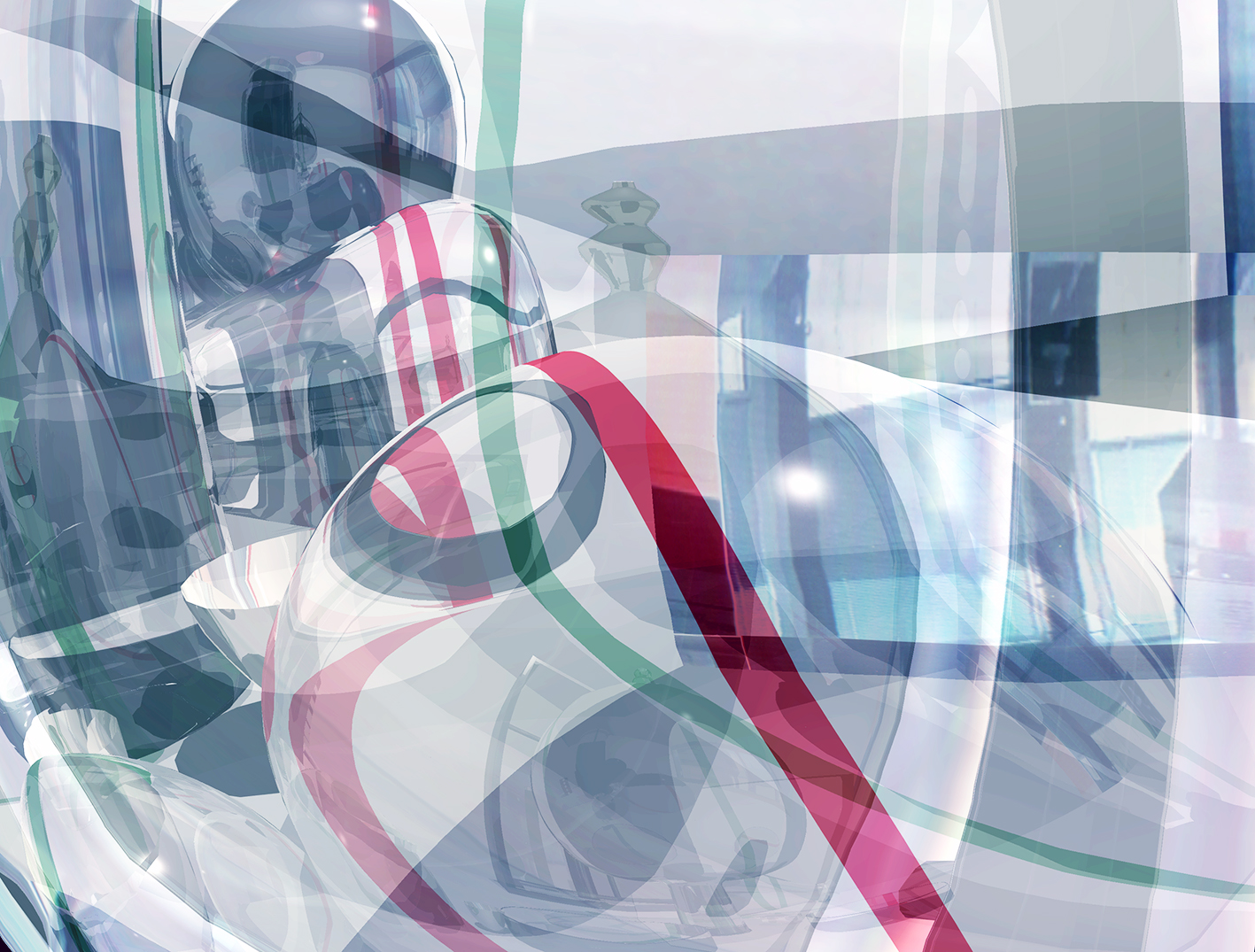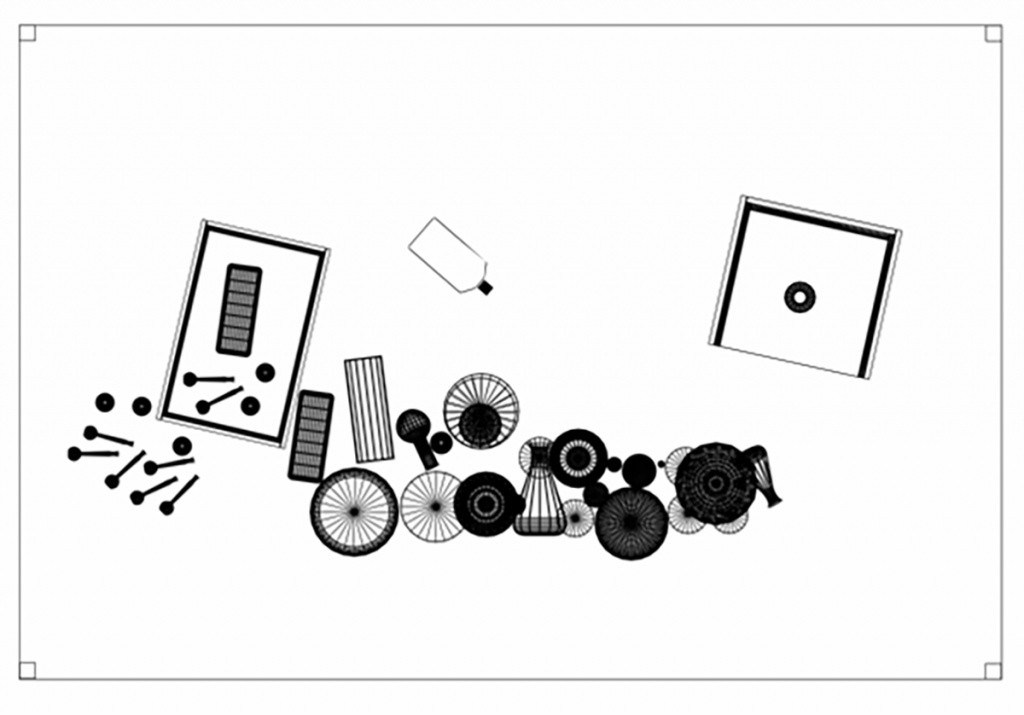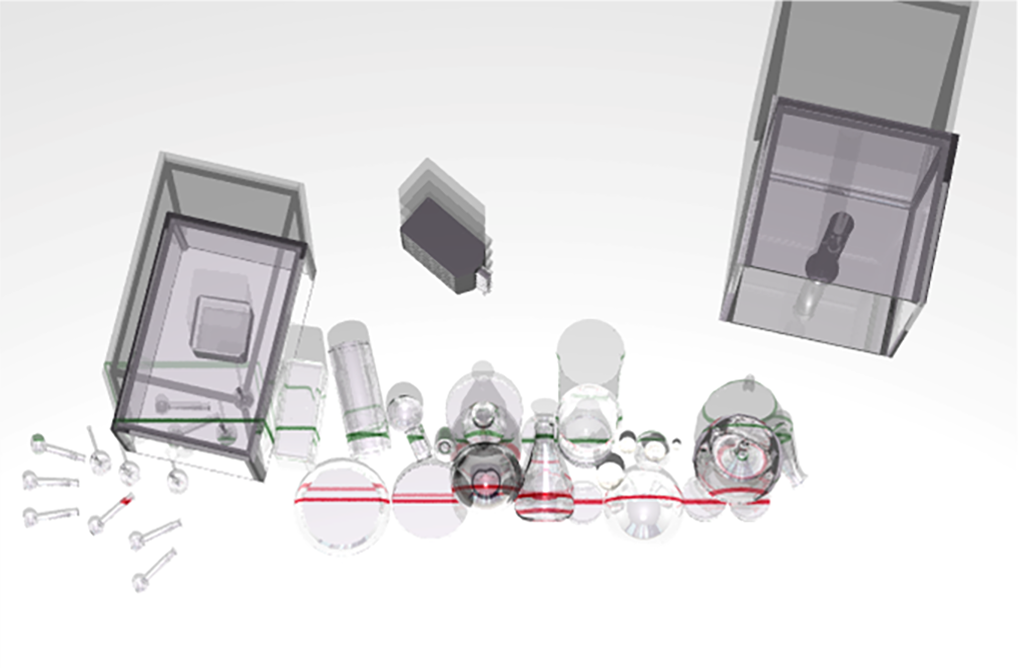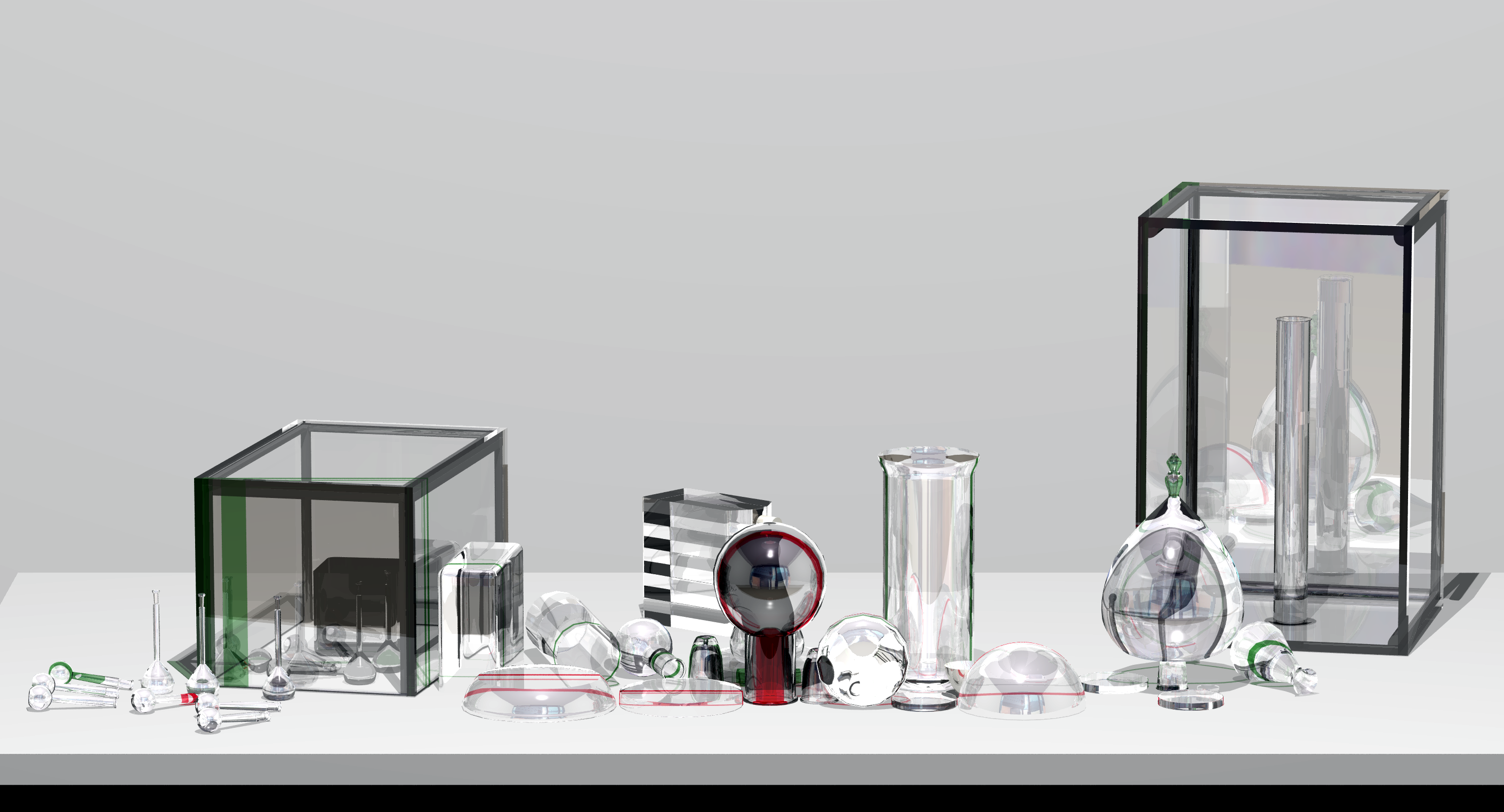translate 2020 first stage: 9 cm
Intro
The text passeges are excerpts from the discussion between Susanne Witzgall and Tyyne Claudia Pollmann, printied in the catalogue DANN/DONE.
Witzgall: The translate 2020 project you mentioned was created between 2000 and 2002 and comprises three groups of works, each centered on a laboratory table with corresponding glass containers commonly used in research. The project was initiated by conversations with computer and media scientists, which largely revolved around the parameters for creating scientific models and their translatability into different disciplines. The conversation with Prof. Joseph Weizenbaum subsequently inspired you to work 9 cm with the animation Ich sehe was, was du nicht siehst und das ist rot! As a second stage and as a reaction to a conversation with the computer science professor Prof. Bärbel Mertsching followed the work dreamachine, which consists of an installation with an extended arrangement of the mentioned lab table, three cibachromes and an animation and was created for Ada Lovelace. Finally, the final stage, entitled transfigure Nietzsche, also includes cibacromes and animations that refer to Nietzsche especially to his writing The Merry Sciences.
Pollmann: In conversation with Joseph Weizenbaum, we found that a possible contact point between science and art is their common concern with creating models of reality. The entire construct of science can be seen as a model, as an attempt to make statements about reality. This model, however, only satisfies the theories on which it is based, and not reality. 9 cm makes visible this limited recording of reality by means of a cut. But not the examination material is examined, but the containers themselves! They reveal information about the investigator. Their tools (…) are therefore the component of the material, from which the human being reconstructs the world like a model. In this spiritual and social world, which they create, they imagine and rehearsesindividual countless stage performances on the subject, how the world possibly once was and what could become of it. This world is the container of their subjectivity. Therefore, it is the stimulating means of their consciousness and finally the architect of the material world itself. It is this self-created world to which the individual is subjected as to a seemingly external power. But it contains everything in itself; what they face is their own model of a universe and, since they are a part in it, also their own model which they creates of themselves. *
* Joseph Weizenbaum The Power of the Computer and the Powerlessness of Reason
translate 2020 first stage: 9 cm

Let’s start with 9 cm and I see something you don’t see and that is red. The first title refers to the distance between two characteristic lines on the above mentioned glass containers on the lab bench, which mark the position of possible cross-sections through these hollow shapes. The second title refers to a children’s game in which the players have to guess which object of the mentioned color is the one they are looking for. The first title already seems to refer to the narrow limitation or range of scientific perception, the second to its selectivity – one perceives only that to which one’s attention has been drawn in advance (be it in the form of a special question or theory). In both cases, however, not natural cell materials are examined, but apparently the glass containers themselves, which have red and green markings next to the characteristic curves. Can you explain that a little bit more?


An arrangement of various glass containers of scientific practice, among which some containers from everyday life have been smuggled, is marked at 9 cm with two characteristic lines at 9 cm intervals as markers of possible cross-sections. The work reveals how minimal the informative value of a cross-section is in the end and deals with this peculiar method. The cross-section is a fusion of two different stereometric conceptions, the three-dimensional and the two-dimensional, and definitionally a real undoing, a really crazy thing. You have a three-dimensional object, and you want to understand it better. What do you do? You cut it in the middle! This gives you an insight into the interior of the object, but you only look at the two-dimensional cut surface. So, you reduce your view by one dimension. But the cut surface becomes representative for the three-dimensional object. Through the loss of dimension, one thus obtains new data, which in turn become representative of the whole. This method of cross-section is, of course, not only common in the medical field, but also in the humanities and social sciences.
The loss of dimension, the loss of information, the excerpting has to be accepted in order to arrive at a new kind of representation and at the same time, it means the abandonment of the universalistic idea that everything can be captured at the same time with an ultimate method. On the contrary, one deals with selected excerpts, it is always about selected relations with reduced expressiveness. This alternation between a two- and a three-dimensional conception with alternating loss of dimension or distance and the subsequent retreat into the next dimension is obviously a very essential form of locomotion. Not only for the fields of science and art. This is also happening now, for example: we talk about my work from a distanced perspective and see other things than those I perceive during the realization of the project. And our instrument is language.
In the computer animation: I see something you don’t see and it’s red! a virtual camera drove through the simulated laboratory containers. The scientific containers themselves in turn became the material for examination, now showing themselves from unusual perspectives that had almost no recognition value and were therefore extremely difficult to classify, i.e., to see. Here, the role of the viewer’s perspective regarding perception is addressed, which then later in the work mental mappings becomes spatially experienceable for the viewer.
She has no behind.
Dialogue between Prof. Joseph Weizenbaum and Tyyne Claudia Pollmann
For translate 2020, Berlin, 2000
Pollmann: …it’s about not expecting technology to deliver anything to us, but to develop a different way of thinking that allows us to see our problems differently. In other words, a completely different approach. Not continuing in the same old rut.
Weizenbaum: And not just in the lab, but in everyday life. That’s what adds to it. We have to try to think differently and live differently. And that means that we may have to do without various things; and that’s very difficult for us. In addition to that, there’s the way we – I mean especially us whites in the North – have organized and are organizing our world. I think of capitalism. We hear in the media all the time that what contributes to economic growth is good. But it can’t go on forever. It just needs to be that way to be able to maintain this system, capitalism. But if we understand that the system will eventually break us, really murder us, that it will become impossible to live on this earth, then we should think of something else. But the people who spend their time counting their stocks are not investing anymore. What they are doing is not an investment, it is a game. Those who are lucky enough to get out at the last moment gain a lot of money. And besides, it also means recklessness. If my values double, I’m rich and I don’t care about the others. The association I have with this is what Pastor Niemüller once wrote: “First they got the Communists, and since I wasn’t a Communist, I had nothing to fear. Then they got the socialists and since I was not a socialist, and so on. And when they finally came to get me, there was no one to help me.” That’s the mentality of the stock market game. And that’s not a mistake that capitalists make, that’s capitalism. And we need growth for that. That’s crazy, we don’t need that: just the other way around! I think it’s just absurd. It’s a Faustian pact. We’re saying to ourselves again, whether in such words or others, the natural scientists will solve the problems.
Pollmann: Yes, as if natural science were something inhumanly perfect and not a human attempt to grasp something of reality. Natural science consists of agreements, there is never clear proof or incontrovertible experiments, but there are approximations, error substitutions, new points of view. And science is always being rewritten. 20 years later, someone comes up with another theory, and then you think about whether you should accept this new theory or not. Basically, maybe it’s about putting the image of science into perspective.
Weizenbaum: I have something very concrete to say about that. Natural science is the religion of our world; it is a kind of superstition. In this context, I have an experiment that I have done many times. I ask, “Who believes that the sun revolves around the earth?” Almost nobody. “Who believes that it is the other way around, that is, that the earth revolves around the sun?” Almost everyone. Now comes the question, “How do you know? Who can give me an argument that it is so?” And then some come up with Newton, Galileo, and who knows what, so great authorities, “Science says it’s so.” Then I say, “But can you give me an argument?” Almost nobody has an argument. It’s a belief just like people in the Middle Ages believed there was a hell with eternal fire, and angels flying around somewhere.
W: What if the scientists say tomorrow that we were wrong, that the sun does revolve around the earth, then you would have to believe that again. So, it is a kind of superstition. It’s simple; the professors with PhDs are the priests of the scientific community and the professors are the high priests and the members of the academy are the very highest priests and so on. – Then I cheat a little bit, I say: “But we see every day that the sun moves and not the earth, so we see, the sun sets, the sun rises! Yet you don’t believe what you see?” The fact is that people believe in the authority of natural scientists. They don’t even realize that I cheated a little bit here. The fact that we see the sun moving around the earth with sunrise and sunset, that really only has to do with the earth rotating on its own axis. But if I get away with this false argument, then it proves the superstition even more emphatically.
Pollmann: Can you explain how it works?
Weizenbaum: Yes, I can explain it: I can turn one hand around the other and then it is arbitrary whether I say the right hand turns around the left or vice versa. In fact, now I move both hands. You can see it this way or you can see it another way. It can be random or there can be a reason that you choose one view instead of the other. And so, it is with the sun and the earth. It is true that the earth revolves around the sun, it is also true that the sun revolves around the earth. Why does modern science say that it is the Earth that revolves around the Sun, that is, that the Sun is the center of our planetary system? Quite simply, the answer is that the mathematics then used to plot the course of the planets in the case where the Sun is placed at the center is much simpler than if the Earth were placed at the center. This is the reason. Before Newton, after all, there was this Ptolemaic model with quite difficult calculations for the motion of the planets….
And this is not wrong. It’s very complicated and it’s much easier to put the sun in the center and then it’s nice circles and ellipses and so on and it goes quite well. Now if we go out much further we see that we are a tiny part of the Milky Way, we are just a corner of the Milky Way, we are not somewhere in the middle around which everything revolves. Our solar system is a tiny part of the Milky Way, and the Milky Way is not at the center of the universe either, as far as we know. That is also somewhere far away. You could also define a different center it’s just that the mathematics then becomes very, very complicated.
Pollmann: Is mathematics also to be understood as a model of thinking? Mathematics also consists of agreements. There are axioms, propositions that cannot be derived any further, propositions that can be drawn from it…
Weizenbaum: … in the field of fundamental mathematics it becomes very philosophical, there one can argue. So, for example, one can ask the highly interesting question: Do we discover mathematics or do we invent it? Maybe it is a model that is so transferable and seems to be so universal that we base everything on it – and much with very great difficulty, and much not at all. The transference is often very artificial. Take love, for example: we have a couple who love each other, so the man loves the woman and the woman loves the man. Can we now add the man’s love for the woman to the woman’s love for the man? We can certainly find a model in which that is possible in some sense.
Pollmann: These whole areas of life are not to be grasped mathematically at all…
Weizenbaum: That is a big question: is the world calculable through and through? As I see it: absolutely not. So it is not calculable. And especially man and human knowledge are not calculable. Much of what we know, we cannot say. It may also be that what we know and can’t say is the most important thing….
Pollmann: I am currently thinking about whether it would not be possible to develop a completely different kind of mathematics under different paradigms, for example, a different form of set theory.
Weizenbaum: I believe that the mathematics we have developed – developed is a nice word here – is a function of our way of thinking. So it’s quite physical. We can’t help ourselves. That’s the way our brain is. We always must go back to that. Bertrand Russel once said, “Mathematics is the discipline in which we never know what we are talking about. Or if we do know, we don’t know whether what we’re saying is true or not.” In the case of economics, economic mathematics for example, we have beautiful models that are mathematically quite clean, but unfortunately economics doesn’t work that way. Economics has to do with people.
Pollmann: So, you think there’s no point in trying to construct the model ever more perfectly, but in human-connected systems there are fundamentally different qualities that cannot be captured by mathematical models.
Weizenbaum: Exactly, that’s it. And that leads us back to Ionescu’s statement, “Everything can basically be said, except existential truth.” We’re talking about sayability in general, which also concerns the language of mathematics. And here I think lies the task and the indispensable frustration of the artist. The poet, for example, tries to somehow overcome the usual limits of natural language. In the end, a poem emerges. It perhaps says much more than can be expressed in simple language or mathematics.
Pollmann: But still, there is a limit. And that is the source of the artist’s inevitable frustration. But the limits are shifted.
Weizenbaum: But that is to the artist’s credit. It is reported of Picasso that he was once asked about his Guernica painting, “What does it mean?” Picasso replied, “Yes, if I could tell you that, I would be a writer. But as it is, I am a painter.” Or Picasso again: there is someone standing in front of a portrait of a woman. It’s a profile, but it shows two eyes. The viewer turns to Picasso and asks, “Why do you paint like that, a woman doesn’t look like that! Here, wait a minute, I’ll show you how a woman looks!” He reaches into his pocket and pulls out a photograph and says, “Here for example, this is my wife.” Picasso takes the picture in his hand, he looks at it and he strokes it, then he turns it around, strokes the backside, gives it back to the man and says, “You know, your wife is very flat. And, she has no behind”.
